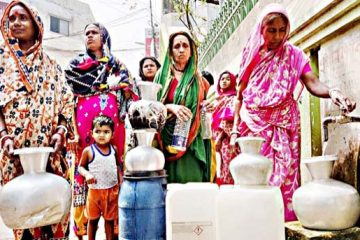Sadiq Ahmed for The Daily Star
 Bangladesh has achieved good economic performance over the past few years. It has successfully managed the transition from the global financial crisis of 2008-10 with relatively modest slowdown in economic activity. Economic growth has recovered and official data suggest that growth is on the upswing. While there is some debate about the magnitude of the upswing, mainly owing to the contentious unprecedented estimated growth in agriculture, there is enough corroborative evidence that economic recovery has indeed happened.
Bangladesh has achieved good economic performance over the past few years. It has successfully managed the transition from the global financial crisis of 2008-10 with relatively modest slowdown in economic activity. Economic growth has recovered and official data suggest that growth is on the upswing. While there is some debate about the magnitude of the upswing, mainly owing to the contentious unprecedented estimated growth in agriculture, there is enough corroborative evidence that economic recovery has indeed happened.
In particular, the strong recovery in manufacturing growth, supported by the surge in the expansion of manufacturing exports, suggests that an overall GDP growth in the range of 6 percent plus is very much a reality. Exports have grown at an amazing rate of 42 percent in nominal dollars in fiscal 2011, making Bangladesh amongst the highest export growth achievers in the world. Other indicators of an expanding economy are the growth in imports (45 percent in nominal dollars in fiscal 2011) and credit growth to the private sector (29 percent). On the social side, the latest Household Income and Expenditure Survey (HIES 2010) shows that national poverty has declined by around 9 percentage points between 2005 and 2010. As a result, the overall poverty rate declined from 40 percent in 2005 to 31.5 percent in 2010.
All this is good news. But there are some dark clouds. A major concern is the rising rate of inflation that has now climbed to 10.2 percent in May (year-on-year). A second worrisome development is the growing trade (including services) imbalance owing to the unprecedented growth in imports. While both exports and imports are expanding, indicating a buoyant economy, the trade gap is widening because of the much larger import base. On the other hand, commensurate increases in financing from remittances, and net capital flows from direct foreign investment, portfolio investment and foreign aid have not kept pace with the rising trade gap. As a result, considerable pressure has been exerted on the reserves and the exchange rate. Foreign reserves as a share of month of imports (goods and services) has fallen from a high of 5 months in fiscal 2010 to less than 3 months in fiscal 2011. The inter-bank exchange rate has depreciated from Tk 69 per dollar in July 2010 to Tk 75 as of July 5. The rate in the curb market has gone up to Tk 78 per dollar.
A review of Bangladesh’s long term development performance suggests that macroeconomic stability has been a hallmark of economic policy management and has played a substantial role in helping secure increases in long-term growth. This is one policy conclusion that cannot be contested and must be recognised by the policymakers moving forward. Hence, the emerging evidence that the macroeconomy is under stress needs careful management to avoid a brake to the long-term growth process.
Policymakers are rightly worried about these developments. In response, a number of policy actions have been taken. While some of these policy actions are welcome, yet a coordinated, comprehensive approach to managing the macroeconomy has not happened. As a result, conflicting signals are emerging that could undermine the effectiveness of these policies.
Monetary policy has been tightened to contain domestic demand pressure on inflation and the balance of payments. The exchange rate has been allowed to depreciate while also letting some drawdown of reserves to stem the fall of the Bangladesh currency. But these corrective measures of Bangladesh Bank (BB) are coming under pressure from politicians and business. Because of these pressures, the ability of BB to sustain the tightening of monetary policy is becoming questionable. Additionally, an expansionary budget for fiscal 2012 has been announced to finance the increase in public investment required to support higher economic growth.
The budget in terms of the size of public spending and the planned fiscal deficit is consistent with the government’s growth target and also preserves debt sustainability. But the absence of an appropriate deficit financing policy and questions about the ability to achieve the budget targets for subsidy spending and tax collections raise a concern that the budget’s reliance on bank borrowings might create further problems for BB’s ability to achieve a lower growth rate of money supply.
Students of economics will realise that the situation that has emerged in Bangladesh is a classic example of the challenge of ensuring the consistency of macroeconomic policies with targets in an open economy. Bangladesh has three macroeconomic targets: a growth target (to support higher employment and poverty reduction); an inflation target (to maintain internal economic stability); and a target for stability of the balance of payments (external stability target). To achieve these targets, it needs some combination of three policy instruments: monetary policy, fiscal policy, and policies for managing the balance of payments. Monetary policy works primarily through the interest rate; fiscal policy primarily through tax and expenditure instruments; and the balance of payments primarily through trade policy, foreign borrowing, reserve management and exchange rate. But each of these policies has implications for mutual effectiveness through the second round interactive effects. As a result, proper coordination is needed to achieve all three macroeconomic targets in a sustainable manner.
In the present Bangladesh situation, high inflation and pressure on the balance of payments are symptomatic of what economists call ‘over-heating’. While high demand for import and domestic credit suggest a robust and growing economy, their pressure on inflation and balance of trade gap suggest that demand is growing much faster than is prudent and is becoming inconsistent with domestic and external macroeconomic stability. The symptoms of emerging macroeconomic instability are rising inflation and rapidly growing trade deficit.
To correct these imbalances, BB has taken the proper policy decision to lower the growth of money supply through a range of measures involving increases in the repurchase (repo) and reverse repurchase (reverse repo) rates and by ensuring that the statutory liquidity reserves (19 percent) are indeed in compliance. Efforts are also being made to keep the credit-deposit ratios (cdr) within prudent levels (around 80 percent). These policies are aimed at reducing the 22 percent a year rate of growth of money supply of the past 24 months to the prudent rate of 15-16 percent as per the target in the monetary policy statements since 2009. The result of this monetary tightening will be an increase in the rate of interest that will reduce domestic demand and thereby reduce the pressure on prices and imports. To stem the demand pressure on imports, BB has also taken the correct policy action of letting the exchange rate depreciate in order to avoid a major run on reserves.
The policy package of monetary tightening and exchange rate adjustments is already showing some result in terms of reducing the pressure on the demand for imports. The impact on inflation will require more time. But importantly, for the full effects to be realised monetary tightening must be preserved until the 16 percent growth target in money supply is achieved.
Let me now bring in the fiscal policy. The expansionary fiscal policy is rightly targeted on achieving higher growth. But it has three downside risks that need to be addressed. First, the tax revenue targets are too much dependent on imports, the growth of which may not happen at the budgeted level. Second, the size of the energy subsidy bill is contingent upon domestic pricing adjustments that may not happen. And third, the external financing target is optimistic and not supported by a proper borrowing strategy. If tax and subsidy targets are not achieved, either the investment target will not be realised, which will compromise the growth target, or the deficit target will not be achieved, which will lead to excessive bank borrowing and threaten the objective of lower monetary growth. Similarly, without a strategy to mobilise adequate financing from external sources, the budget will either squeeze out the private sector or jeopardise the monetary growth target.
What is the way out of this difficult macroeconomic situation? Is the 7 percent GDP growth target inconsistent with macroeconomic stability? The answer is “not necessarily”.
There are ways in which this higher growth target can be achieved while restoring macroeconomic stability. This requires proper coordination of the three sets of policies with the three objectives. The primary objective of monetary policy must be to lower inflation and maintain the stability of the exchange rate. Monetary policy must be allowed to reduce the growth of money supply to the 15-16 percent rate targeted in the monetary policy statements of the past two years but never achieved. This will increase interest rate to some extent and thereby reduce excess demand pressure on prices and imports. Lower growth of imports will reduce the pressure on the balance of payments and the exchange rate. It should be noted that a 16 percent monetary growth target is consistent with 7 percent GDP growth rate and an inflation rate of 6-7 percent.
Fiscal policy should secure a reduction in energy subsidies through proper energy pricing and also ensure the achievement of the revenue targets by widening the tax net. The obvious candidates are capital gains from real estate and stock markets and the introduction of a broad-based property tax. Fiscal policy should also aim to increase the efficiency of public spending and reduce corruption through proper public expenditure management. On the financing side, the finance ministry ought to develop and implement a sound borrowing strategy that draws a proper balance between domestic and external financing and between bank and non-bank domestic financing. Proper pricing of public utilities and reforms of public enterprises will also be of help in containing public sector bank borrowings. Greater official financing along with better aid utilisation will help both the budget and the balance of payments. This is an additional policy instrument for reconciling higher with macroeconomic stability.
If such a coordinated macroeconomic policy stance is not adopted then growth and macroeconomic stability targets will become inconsistent. The political demands for simultaneously maintaining a low interest rate, a relatively fixed exchange rate, low domestic energy prices, low inflation, exempting important tax sectors from income tax, increasing public investment rate and achieving 7 percent plus GDP growth rates are mutually inconsistent in the current global and domestic economic environment. Pressure to lower interest rate through an easing of monetary policy will fuel inflation and cause a further slide in the exchange rate. Low domestic energy prices in the face of high international prices will increase budget spending and raise the budget deficit or lower public investment. Inability to raise tax revenues will similarly increase the budget deficit or reduce investment spending. The net result will be higher inflation and pressure on the balance of payments or lower growth.
Public policy involves hard choices. Informed choices have a better chance of reconciling conflicting objectives than choices based on populism or pressure from vested interests.
The writer is the vice chairman of Policy Research Institute of Bangladesh. He can be reached at sahmed1952@live.com







